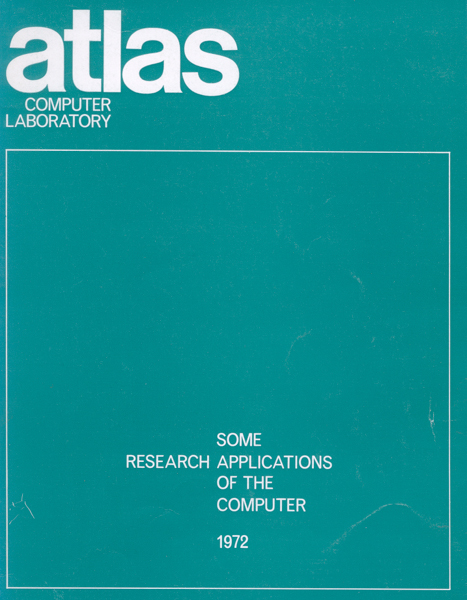


This is the third publication of this type put out by the Atlas Laboratory. As before the aim is to illustrate, by means of what is necessarily a very small sample, the range and variety of work which goes on in a large central computing organisation. And again the papers have been contributed both by staff members and by users of the Laboratory. The reader will observe that none of the authors puts any great stress on the amount of computation involved in his work - except Lunnon, on whom I comment below. Actually, whilst scarcely any of the work reported here would have been remotely possible without the aid of a powerful computer, none of it does involve exceptionally heavy computation by present-day standards. We seem now to have got to the position where computers are so fast that the ability to get through huge masses of arithmetic can be taken for granted and is not intrinsically interesting. I hope readers will find broader interests, and perhaps some computational elegancies, in the material we are printing.
The papers are intended to be self-explanatory, but I should like to make brief comments on a few of them. The first two, by Baldwin and Thomas and Thomas and Kent respectively, deal in complementary ways with the multi-access system which we have added to Atlas, and which was designed and implemented in the Laboratory. The interest here is that Atlas itself was not designed as a multi-access machine (remember it was designed in the early 1960's when this was very much a novelty), but a most effective and flexible system was provided in an elegant manner by the use of a small satellite computer. The idea of the satellite or front-end processor is now common, but was less so in 1966 and we feel that we did a certain amount of pioneering. There is a small amount of overlap between the two papers, so that each is reasonably self-contained. Chance and Thermal Equilibrium by Ogborn, Hopgood and Black describes our first serious essay in the production of teaching films by computer. This film is being used in about 200 schools under the auspices of the Nuffield Foundation Teaching Project. Since then we have made several films for the Open University's televised course on mathematics, and we look forward to doing a good deal more work in this field. The Laboratory arranged a Symposium on Computer Animation on 30 July 1971, which proved a lively and stimulating event and showed very clearly the great potentiality of the technique and the interest in its development. Correspondingly, Platts's paper on The Dynamics of the Hovertrain Track deals with the first application in the Laboratory of computer-produced cinematography to a real (and serious) problem. The two number-theory papers by Churchhouse and Stephens respectively show how the computer, used with imagination, can help the pure mathematician; in both cases the amount of computation was quite small. Lunnon's paper on Combinatorial Problems, on the other hand, deals with problems in pure mathematics which are very simple to state but can demand arbitrarily large amounts of time. Fortunately they can be organised so that the programs can reside in the machine for very long periods and as it were pick up whatever spare time is going. The application of the computer, a finite device, to pure mathematics, which is concerned essentially with infinite classes, is clearly a field in which imagination and understanding will win over brute force; the Laboratory has contributed to this field by arranging two international Symposia in Oxford in 1967 and 1969 on applications in abstract algebra and in number theory respectively.
To redress the balance in favour of the applied side we arranged a third in 1970 on applications to radiative transport theory. Proceedings of all three have been published, with the following titles:
SRC Atlas Symposium No. 1 - Oxford 1967 Computational Problems in Abstract Algebra Ed. John Leech Pergamon Press 1970
SRC Atlas Symposium No.2 - Oxford 1969 Computers in Number Theory Ed. A. O. L. Atkin and B. J. Birch London: Academic Press 1971
SRC Atlas Symposium No.3 - Oxford 1970 Proceedings of the Symposium on Interdisciplinary Applications of Transport Theory Ed. G. E. Hunt in Journal of Quantitative Spectroscopy and Radiative Transfer, 11 (6), 1971.
Finally, a few words about the Laboratory's equipment. The Atlas computer, now clearly recognised as a classic machine, is still giving splendid performance. An ICL 1906A with large amounts of storage and including communications equipment for control of remote work stations was installed in a new machine block in the second half of 1971. An interactive graphics system made up of a PDP 15 computer and VT 15 programmable display was installed in 1971 and will be linked to the 1906A during 1972. The Laboratory has been allotted a share of the time of the large and powerful IBM 370/195 which was installed in the adjacent Rutherford High Energy Laboratory in November 1971, and has itself installed an IBM 1130 and a fast (50K bits/second) link so that this machine can be used from within the Atlas Laboratory. The effect of all this is that, broadly speaking, the computing power available to the Laboratory is now equivalent to about 6-8 times Atlas, together with greatly increased information storage, and there are much greater possibilities for access by data links and remote job-entry stations.
The papers in this volume are placed around the site in the most appropriate place. Links only are provided here.